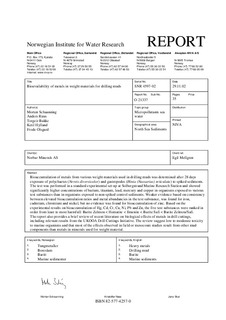| dc.contributor.author | Schaanning, M. | nb_NO |
| dc.contributor.author | Ruus, A. | nb_NO |
| dc.contributor.author | Bakke, T. | nb_NO |
| dc.contributor.author | Hylland, K. | nb_NO |
| dc.contributor.author | Olsgard, F. | nb_NO |
| dc.contributor.other | Schaanning, M. - Project manager | nb_NO |
| dc.coverage.spatial | Norge | nb_NO |
| dc.date.accessioned | 2014-08-01T10:47:35Z | |
| dc.date.available | 2014-08-01T10:47:35Z | |
| dc.date.issued | 2002 | nb_NO |
| dc.identifier | 4597 | nb_NO |
| dc.identifier.isbn | 82-577-4257-0 | nb_NO |
| dc.identifier.issn | 1894-7948 | nb_NO |
| dc.identifier.uri | http://hdl.handle.net/11250/211877 | |
| dc.description | Årsliste 2002 | nb_NO |
| dc.description.abstract | Bioaccumulation of metals from various weight materials used in drilling muds was determined after 28 days exposure of polychaetes (Nereis diversicolor) and gastropodes (Hinia (Nassarius) reticulata) to spiked sediments. The test was performed in a standard experimental set-up at Solbergstrand Marine Research Station and showed significantly higher concentrations of barium, titanium, lead, mercury and copper in organisms exposed to various test substances than in organisms exposed to non-spiked control sediments. Weaker evidence based on consistency between elevated bioaccumulation ratios and metal abundancies in the test substance, was found for iron, cadmium, chromium and nickel, but no evidence was found for bioaccumulation of zinc. Based on the experimental results on bioaccumulation of Hg, Cd, Cr, Cu, Ni, Pb and Zn, the five test substances were ranked in order from least to most harmfull: Barite Zelmou < Hematite < Ilmenite < Barite Safi < Barite Zelmou/Safi. The report also provides a brief review of recent litterature on biological effects of metals in drill cuttings, including relevant results from the UKOOA Drill Cuttings Initiative. The review suggest low to moderate toxicity to marine organisms and that most of the effects observed in field or mesocosm studies result from other mud components than metals in minerals used for weight material. | nb_NO |
| dc.description.sponsorship | Norbar Minerals AS | nb_NO |
| dc.publisher | Norsk institutt for vannforskning | nb_NO |
| dc.relation.ispartofseries | NIVA-rapport;4597 | nb_NO |
| dc.rights | Navngivelse-IkkeKommersiell-DelPåSammeVilkår 3.0 Norge | nb_NO |
| dc.rights.uri | http://creativecommons.org/licenses/by-nc-sa/3.0/no/ | nb_NO |
| dc.subject | miljøgifter - marint | nb_NO |
| dc.title | Bioavailability of metals in weight materials for drilling muds | nb_NO |
| dc.type | Research report | nb_NO |
| dc.rights.holder | Norsk institutt for vannforskning/Norwegian institute for water research | nb_NO |
| dc.subject.nsi | VDP::Matematikk og naturvitenskap: 400 | nb_NO |
| dc.source.pagenumber | 36 | nb_NO |
| dc.subject.keyword | tungmetaller | nb_NO |
| dc.subject.keyword | boreslam | nb_NO |
| dc.subject.keyword | baritt | nb_NO |
| dc.subject.keyword | marine sedimenter | nb_NO |
| dc.subject.keyword | heavy metals | nb_NO |
| dc.subject.keyword | drilling | nb_NO |
| dc.subject.keyword | mud | nb_NO |
| dc.subject.keyword | barite | nb_NO |
| dc.subject.keyword | marine | nb_NO |
| dc.subject.keyword | sediments | nb_NO |
| dc.relation.project | O-21337 | nb_NO |


